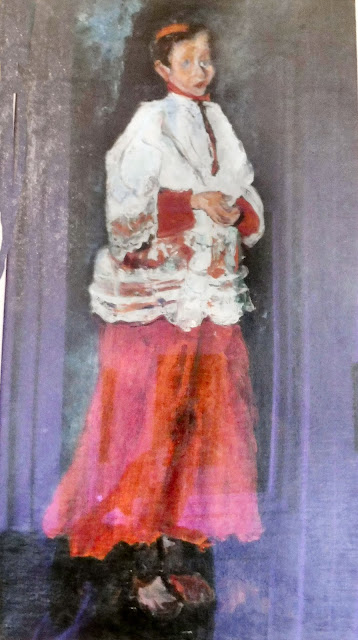The Fine Arts Museum (Musée des Beaux-Arts), situated just behind the Chartres Cathedral, was the ancient Bishop’s Palace (Palais Episcopal) from the 12th century, where the bishops of Chartres lived. The former bishop’s palace welcomed King Henry IV for his coronation, which was the only coronation that took place outside of Reims, where monarchs were traditionally crowned. The castle of the bishop’s representative, built at the top end of the cathedral was demolished in the 17th century. The demolition of old parts of the palace enabled three levels of terraced gardens to be created. The building is classified as a historic monument and has housed the Fine Arts Museum since 1939, after being used for the prefecture of the Eure-et-Loir.
Granite sculpture, Synergie, by Tetsuo Harada, a Japanese artist who is based in France and was born on my birthday, August 25, but a few years later.
The sculpture is located on the lookout over the Bishop’s Gardens and the town of Chartres.
The Bishop’s garden has three levels of terraces. In the background of this pic, you can see the peaked roof of the Hôtellerie Saint-Yves, the hotel we stayed at in Chartres.
Steps lead down to the maze and another level of the Bishop’s Garden.
The maze in the Bishop’s Garden
This is a maze, not a labyrinth. A maze has choices of path and direction as well as dead ends. A labyrinth has only a single path leading to the center and back out again.
The side of the Bishop’s Palace facing the overlook
The bushes don’t get perfectly conical by accident.
The entry to the museum
The grand foyer of the museum
The grand foyer of the museum
Housed in the former Bishop's Palace, the Museum of Fine Arts in Chartres presents 16th century enamels of the apostles, made for Francis I, sculptures and medieval religious objects, paintings dating from the 16th to the 19th century as well as modern art, and polychromatic wooden sculptures from the Middle Ages. The collections were very interesting, but definitely eclectic. I thought that a bishop’s museum would contain mostly religious or sacred items. This wasn’t the case. The reason might be that the museum’s collections were donated rather than acquired. As donations increased, the museum grew to accommodate them. The result is a wide range of artistic works and a surprise around every corner.
The indoor vestibule, an Italian-style room, houses the alabaster sculpture of Saint-Paul by François Marchand (1500-1551)
In the vestibule also is Metabus, roi des Volsques (Metabus, king of the Volsci) by Léon Cogniet (1794-1880). This reference is to Virgil’s Aeneid, a Latin epic poem written between 29 and 19 BC, which tells the story of Aeneas, ancestor of the Romans.
According to the ancient Roman myth, Metabus is driven from his throne and chased into the wilderness by armed Volsci, his infant daughter, Camilla, in his hands. The river Amasenus blocked his path, and, fearing for the child's welfare, Metabus bound her to a spear. He promised Diana that Camilla would be her servant, a warrior virgin. He then safely threw her to the other side, and swam across to retrieve her. The baby Camilla was raised to be a huntress and remained in the hills and woods with her father and shepherds.
An altar to the Blessed Virgin, preserved from a previously destroyed chapel
Close up of the altar
An eagle lectern
Les Douze Apôtres by Leonard Limousin (1505-1575)
On the wall are 16th-century enamels of the Apostles made for François I by his court painter, Limousin.
On the wall are 16th-century enamels of the Apostles made for François I by his court painter, Limousin.
Medieval religious objects, including a crucifix, in a glass case, with the Apostles in the background
A continuation of the Apostle enamels
The gallery of paintings includes Leda and the Swan by Francois Boucher.
In Greek mythology, the god Zeus transformed himself into a swan and seduced Leda.
17th century Dieu apparaît à Abraham (God appears to Abraham)
18th century Sainte en Extase (Saint in religious ecstasy) by Guiseppe Bazzani (1690-1769)
18th century Portrait équestre de Catherine II, en uniforme d’officier
by Vigilius Erichsen (1722-1782)
16th century polychromatic wooden sculptures
16th century Les Deux Larrons (The two thieves, crucified with Christ)
polychromatic wooden sculptures
19th century Tuerie (Slaughter) Fragment épisodique d’un grand bas relief by Auguste Preault (1809-1879) Sculpture depicting figures in anguish violently tearing at each other.
19th century Jeune fille endormie (Young girl asleep) by Thomas Couture (1815-1879)
19th century Le Printemps (Springtime) by Charles-François Daubigny (1817-1878)
19th century Le retour du marché (Return from market) by Constant Troyon (1810-1865)
20th century Leda et le cygne (Leda and the swan) by Octave Morillot (1878-1931)
Morillot was a navy officer who left the navy to live and paint on the island of Tahiti. The French colonial governor, Louis-Joseph Bouge, acquired this and other South Pacific artwork and donated the collection to the museum.
20th century Clochard (Bum) by Anton Kruysen (1898-1977)
20th century Le Cathédrale Illuminée (The Cathedral illuminated) by Anton Kruysen (1898-1977)
20th century A gallery of paintings by Maurice de Vlaminck (1876-1958)
20th century Nature Morte au panier de fruits (Still life with basket of fruit) by Maurice de Vlaminck (1876-1958)
20th century Nature Morte aux nevets (Still life with turnips) by Maurice de Vlaminck (1876-1958)
20th century Portrait du père de l’artiste (Portrait of the artist’s father) by André Derain (1880-1954)
20th century Le raie (The manta ray) by Chaïm Soutine (1893-1943)
20th century Les escaliers de Chartres (The stairways of Chartres) by Chaïm Soutine
20th century Le grand enfant du choeur (The tall choir boy) by Chaïm Soutine (1893-1943)









































This comment has been removed by a blog administrator.
ReplyDelete